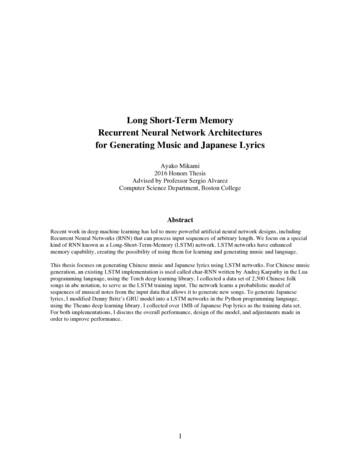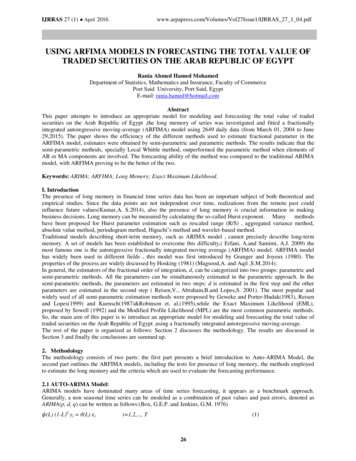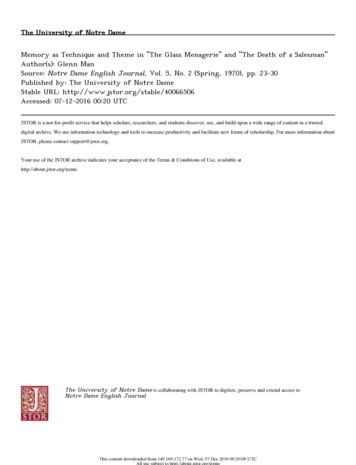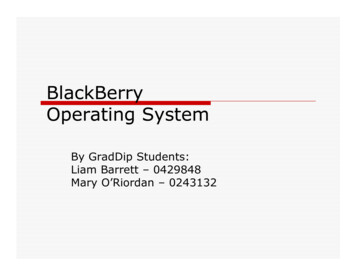
Transcription
Long Short-Term MemoryRecurrent Neural Network Architecturesfor Generating Music and Japanese LyricsAyako Mikami2016 Honors ThesisAdvised by Professor Sergio AlvarezComputer Science Department, Boston CollegeAbstractRecent work in deep machine learning has led to more powerful artificial neural network designs, includingRecurrent Neural Networks (RNN) that can process input sequences of arbitrary length. We focus on a specialkind of RNN known as a Long-Short-Term-Memory (LSTM) network. LSTM networks have enhancedmemory capability, creating the possibility of using them for learning and generating music and language.This thesis focuses on generating Chinese music and Japanese lyrics using LSTM networks. For Chinese musicgeneration, an existing LSTM implementation is used called char-RNN written by Andrej Karpathy in the Luaprogramming language, using the Torch deep learning library. I collected a data set of 2,500 Chinese folksongs in abc notation, to serve as the LSTM training input. The network learns a probabilistic model ofsequences of musical notes from the input data that allows it to generate new songs. To generate Japaneselyrics, I modified Denny Britz’s GRU model into a LSTM networks in the Python programming language,using the Theano deep learning library. I collected over 1MB of Japanese Pop lyrics as the training data set.For both implementations, I discuss the overall performance, design of the model, and adjustments made inorder to improve performance.1
Contents1.Introduction . . . . . . . . . . . . . . . . . . . . . . . . . . . . . . . . . . . . . . . . . . . . . . . . . . . . . . . . . . . . . . . . . . . . . 31.1 Overview . . . . . . . . . . . . . . . . . . . . . . . . . . . . . . . . . . . . . . . . . . . . . . . . . . . . . . . . . . . . . . . . . . . . . 31.2 Feedforward Neural Networks . . . . . . . . . . . . . . . . . . . . . . . . . . . . . . . . . . . . . . . . . . . . . . . . . . . . . 41.2.1 Forward Propagation . . . . . . . . . . . . . . . . . . . . . . . . . . . . . . . . . . . . . . . . . . . . . . . . . . . 41.2.2 Backpropagation . . . . . . . . . . . . . . . . . . . . . . . . . . . . . . . . . . . . . . . . . . . . . . . . . . . . . . . 51.3 Recurrent Neural Networks . . . . . . . . . . . . . . . . . . . . . . . . . . . . . . . . . . . . . . . . . . . . . . . . . . . . . . 61.3.1Forward Propagation . . . . . . . . . . . . . . . . . . . . . . . . . . . . . . . . . . . . . . . . . . . . . . . . . 61.3.2Backpropagation Through Time . . . . . . . . . . . . . . . . . . . . . . . . . . . . . . . . . . . . . . . . 71.3.3Issue of Vanishing Gradient . . . . . . . . . . . . . . . . . . . . . . . . . . . . . . . . . . . . . . . . . . . 71.4 Long Short-Term Memory . . . . . . . . . . . . . . . . . . . . . . . . . . . . . . . . . . . . . . . . . . . . . . . . . . . . . . . 91.4.1The Cell State and the Three Gates . . . . . . . . . . . . . . . . . . . . . . . . . . . . . . . . . . . . . . 91.4.2Forget Gate . . . . . . . . . . . . . . . . . . . . . . . . . . . . . . . . . . . . . . . . . . . . . . . . . . . . . . . 101.4.3Input Gate . . . . . . . . . . . . . . . . . . . . . . . . . . . . . . . . . . . . . . . . . . . . . . . . . . . . . . . . 101.4.4Updating the Cell Memory . . . . . . . . . . . . . . . . . . . . . . . . . . . . . . . . . . . . . . . . . . . .101.4.5Output Gate . . . . . . . . . . . . . . . . . . . . . . . . . . . . . . . . . . . . . . . . . . . . . . . . . . . . . . . 111.4.6Why LSTM is Superior Over RNN . . . . . . . . . . . . . . . . . . . . . . . . . . . . . . . . . . . . 111.5 Brief Overview of Training, Testing, and Validation . . . . . . . . . . . . . . . . . . . . . . . . . . . . . . . . . .122.Implementation for Generating Traditional Chinese Music . . . . . . . . . . . . . . . . . . . . . . . . . . . . 132.1 Overview of Andrej Karpathy’s char-RNN model . . . . . . . . . . . . . . . . . . . . . . . . . . . . . . . . . . . . 132.2 Input Dataset: ABC notation . . . . . . . . . . . . . . . . . . . . . . . . . . . . . . . . . . . . . . . . . . . . . . . . . . . . . 132.3 Results . . . . . . . . . . . . . . . . . . . . . . . . . . . . . . . . . . . . . . . . . . . . . . . . . . . . . . . . . . . . . . . . . . . . . . 142.3.1 Checkpoints and Minimum Validation Loss . . . . . . . . . . . . . . . . . . . . . . . . . . . . . . . . 142.3.2 Decreasing the Batch Parameter . . . . . . . . . . . . . . . . . . . . . . . . . . . . . . . . . . . . . . . . . . 152.4 Challenges and Performance Evaluation . . . . . . . . . . . . . . . . . . . . . . . . . . . . . . . . . . . . . . . . . . . 183.Implementation for Generating Japanese Lyrics . . . . . . . . . . . . . . . . . . . . . . . . . . . . . . . . . . . . . . 193.1 Preprocessing the data . . . . . . . . . . . . . . . . . . . . . . . . . . . . . . . . . . . . . . . . . . . . . . . . . . . . . . . . . . 193.2 Forward Propagation . . . . . . . . . . . . . . . . . . . . . . . . . . . . . . . . . . . . . . . . . . . . . . . . . . . . . . . . . . . 223.3 Results . . . . . . . . . . . . . . . . . . . . . . . . . . . . . . . . . . . . . . . . . . . . . . . . . . . . . . . . . . . . . . . . . . . . . . 234.Conclusion and Future Work . . . . . . . . . . . . . . . . . . . . . . . . . . . . . . . . . . . . . . . . . . . . . . . . . . . . . . 245.Appendix . . . . . . . . . . . . . . . . . . . . . . . . . . . . . . . . . . . . . . . . . . . . . . . . . . . . . . . . . . . . . . . . . . . . . . . 252
1. Introduction1.1 OverviewIn recent years neural networks have become widely popular and are often mentioned along withterms such as machine learning, deep learning, data mining, and big data. Deep learning methodsperform better than traditional machine learning approaches on virtually every single metric. FromGoogle’s DeepDream that can learn an artist’s style, to AlphaGo learning an immensely complicatedgame as Go, the programs are capable of learning to solve problems in a way our brains can donaturally. To clarify, deep learning, first recognized in the 80’s, is one paradigm for performingmachine learning. Unlike other machine learning algorithms that rely on hard-coded featureextraction and domain expertise, deep learning models are more powerful because they are capableof automatically discovering representations needed for detection or classification based on the rawdata they are fed. [13] For this thesis, we focus on a type of machine learning technique known asartificial neural networks. When we stack multiple hidden layers in the neural networks, they areconsidered deep learning. Before diving into the architecture of LSTM networks, we will begin bystudying the architecture of a regular neural network, then touch upon recurrent neural network andits issues, and how LSTMs resolve that issue.3
1.2 Feedforward Neural NetworksNeural network is a machine learning technique inspired by the structure of the brain. The basicfoundational unit is called a neuron. Every neuron accepts a set of inputs and each input is given aspecific weight. The neuron then computes some function on the weighted input. Functionsperformed throughout the network by the neurons include both linear and nonlinear – these nonlinearfunctions are what allow neural networks to learn complex nonlinear patterns. Nonlinear functionsinclude sigmoid, tanh, ReLU, and Elu; these functions have relatively simple derivatives, which is animportant characteristic that will be discussed later in this section. Whatever value the functionscomputes from the weighted inputs are the outputs of the neuron that are then transmitted as inputsto succeeding neuron(s). The connected neurons then form a network, hence the name neuralnetwork. The basic structure of a neural network consists of three types of layers: input layer, hiddenlayer, and output layer. The diagram below is an example of a neural network’s structure.Diagram 1: An example of a neural network1.2.1 Forward PropagationThe first step in a neural network is the forward propagation. Given an input, the network makes aprediction on what the output would be. To propagate the input across the layers, we performfunctions like that of below:4
The equations z1, z2 are linear functions with x as input and W, b are weights and biases. The a1 inthe hidden linear performs a nonlinear activation function 𝑡𝑎𝑛ℎ. The 𝑡𝑎𝑛ℎ function takes in theinputs z1 and output values in the range of [-1. 1]. In general, the activation function condenses verylarge or very small values into a logistic space, and their relatively simple derivatives allow forgradient descent to be workable in backpropagation. In the output layer, we perform the softmaxfunction that turns the values of z2 into a probability distribution where the highest value is thepredicted output. The equations above are the steps that occur in the forward propagation. The nextstep is backpropagation, which is where the actual learning happens.1.2.2 BackpropagationBackpropagation is a way of computing gradients of expressions through recursive application ofchain rule. [11] The backpropagation involves two steps: calculating the loss, and performing agradient descent. We calculate the loss L by cross entropy loss to determine how off our predictedoutput 𝑦 is from the correct output 𝑦. We typically think of the input 𝑥 as given and fixed, and theweights and biases as the variables that we are able to modify. Because we randomly initialize theweights and biases, we expect our losses to be high at first. The goal of training is to adjust theseparameters iteration by iteration so that eventually the loss is minimized as much as possible. Weneed to find the direction in which the weight-space improves the weight vector and minimizes ourloss is the gradient descent.The gradient descent is an optimization function that adjusts weights according to the error. Thegradient is another word for slope. The slope describes the relationship between the network’s errorand a single weight, as in how much the error changes as the weight is adjusted. The relationshipbetween network error and each of those weights is a derivative,!"!", which measures the degree towhich a slight change in a weight causes a slight change in the error. [10] The weights arerepresented in matrix form in the network, and each weight matrix passes through activations andsums over several layers. Therefore, in order to find the derivative we need to use the chain rule tocalculate the derivative of the error in relation to the weights. If we were to apply thebackpropagation formula for the equations listed from the forward propagation section, we have thefollowing derivatives for the weights in respect to the loss:𝛿𝐿𝛿𝐿 𝛿𝑧! 𝛿𝑎! 𝛿𝑧! 𝑥 ! 1 𝑡𝑎𝑛ℎ! 𝑧! 𝑦 𝑦 𝑊!!𝛿𝑊 !𝛿𝑧 ! 𝛿𝑎 ! 𝛿𝑧 ! 𝛿𝑊 !𝛿𝐿𝛿𝐿 𝛿𝑧! 𝑎!! 𝑦 𝑦𝛿𝑊 !𝛿𝑧 ! 𝛿𝑊 !5
We continually adjust the model’s weights in response to the error it produces iteration after iterationuntil the error can no longer be reduced.1.3 Recurrent Neural Networks1.3.1 Forward PropagationWhile traditional feedforward neural networks perform well in classification tasks, they are limitedto looking at individual instances rather than analyzing sequences of inputs. Sequences can be ofarbitrary length, have complex time dependencies and patterns, and have high dimensionality. Someexamples of sequential datasets include text, genomes, music, speech, text, handwriting, change ofprice in stock markets, and even images, which can be decomposed into a series of patches andtreated as a sequence. [10] Recurrent neural networks are built upon neurons like feedforward neuralnetworks but have additional connections between layers.Diagram 2: Recurrent Neural Network in time steps [2]The diagram above illustrates how the workings of the RNN, when unfolded in time, is very similarto feedforward neural networks. The area highlighted in blue is similar to what is happening in thediagram of the feedforward neural network. There is the input layer 𝑥! , hidden layer 𝑠! , and outputlayer 𝑜! . 𝑈, 𝑉, and 𝑊are the parameters or the weights that the model needs to learn. The differencebetween the feedforward neural network and the RNN is that there is an additional input, 𝑠!!! , fedinto the hidden layer 𝑠! . If the network path highlighted in blue is the current time step 𝑡, then theprevious that is the network at timestep t-1, and the network after happens at time step t 1, in whichthe current hidden layer 𝑠! will be fed into 𝑠!!! along with 𝑥!!! . In the hidden layer, we apply anactivation function to the sum of the previous hidden layer state and current input 𝑥! (in the belowdiagram, the 𝑡𝑎𝑛ℎ activation function is applied). While the left hand side of diagram 2 seems tosuggest that RNNs have a cyclic cycle, the connection between previous time step and current timestep in the hidden state is still acyclic; this is important to recognize because the network needs to be6
acyclic in order for backpropagation to be possible. The diagram below illustrates what is happeningin the hidden state of a RNN:Diagram 3: Hidden State of a RNN [16]Mathematically, we represent the step happening in the hidden state ℎ! as:ht tanh(W xt U ht1)𝑊 and 𝑈 are weight matrices; they are filters that determine how much importance to accord to boththe present input and the previous hidden state. When we feed in the previous hidden state, itcontains traces of all those that preceded ℎ!!! ; this is how the RNN is able to have a persistentmemory. [10]1.3.2 Backpropagation Through TimeIn the backpropagation, we calculate the error the weight matrices generate, and then adjust theirweights until the error cannot go any lower. As we see in diagram 2, the weight matrix 𝑊 is carriedthrough each time step. In order to compute the gradient for the current 𝑊, we need to perform thechain rule through a series of previous time steps. Because of this, we call the process backpropagation through time (BPTT). If the sequences are quite long, the BPTT can take a long time;thus, in practice many people truncate the backpropagation to few steps instead of all the way to thebeginning. [10]1.3.3 Issue of Vanishing GradientWhile in theory the RNN should retain memory through the time steps, in practice RNN performedpoorly. Hochreiter (1991) and Bengio, et al. (1994) explored the problem in depth of why gradientbased learning algorithms face an increasingly difficult problem as the duration of the dependenciesto be captured increases. [8] One major issue is the vanishing gradient problem. As we mentionedbefore, the gradient is the derivative of the loss with respect to the weights. If the gradient is sosmall, we cannot adjust the weights in a direction that decreases the error, and so the network cannotlearn. In a RNN, the layers and time steps of deep neural networks relate to each other throughmultiplication. Multiplying a number slightly greater than one can make the number become7
immeasurably large (exploding), and multiplying a number slightly less than one can diminish tozero very fast (vanishing). [10] Therefore, derivatives or gradients are susceptible to vanishing orexploding in a RNN. We can solve exploding gradients but truncating or squaring the values, butresolving vanishing gradients is harder. Below is a diagram of the graphs of the tanh function and itsderivative.Diagram 4: Graphs of tanh and its derivative 1The tanh activation function maps output values in the range of [-1,1] and the maximum value of thederivative is 1 with 0 at both ends. Weight matrices are randomly initialized to be small values, andwith a derivative that is slightly less than 1, multiplying the derivatives across the previous timesteps can cause the gradients to vanish very rapidly. [15] This prevents learning long-termdependencies and is the cause for RNNs to perform poorly. While there are tricks to overcome thisissue, it does not change the fact that RNNs fundamentally have unstable gradients that can vanishand explode quickly. [15] In the next section, we discuss Long Short-Term Memory Networks, atype of RNN that was discovered in the mid 1900s in order to overcome the issue of vanishinggradients.1"Transfer Function Layers." Nn. Read the Docs, n.d. Web. 06 May 2016. http://nn.readthedocs.io/en/rtd/transfer/#tanh .8
1.4 Long Short-Term Memory1.4.1 The Cell State and the Three GatesLSTM was first introduced in 1997 by Sepp Hochrieiter and Jürgen Schmidhuber. LSTMs arecapable of bridging time intervals in excess of 1000 time steps even in case of noisy, incompressibleinput sequences, without loss of short time lag capabilities. [9] The architecture enforces constanterror flow through internal states of special unit known as the memory cell.There are three gates to the cell: the forget gate, input gate, and output gate. These gates are sigmoidfunctions that determine how much information to pass or block from the cell. Sigmoid functionstakes in values and outputs them in the range of [0,1]. In terms of acting as a gate, a value of 0 meanslet nothing through, and a value of 1 means let everything through. These gates have their ownweights that are adjusted via gradient descent. For the rest of the explanation for the forwardpropagation of the LSTM, we will refer to the diagram below.Diagram 5: The hidden state of a LSTM [17]In the equations listed under the forget gate, input gate, and output gate in the diagram, ℎ!!! is theprevious hidden state, 𝑥! is the current input, 𝑊 is the weight matrix, and 𝑏 is the bias.9
1.4.2 Forget GateThe first step is the forget gate, in which the sigmoid function outputs a value ranging from 0 to 1 todetermine how much information of the previous hidden state and current input it should retain.Forget gates are necessary to performance of LSTM because the network does not necessarily needto remember everything that has happened in the past. For example, if we are moving from onemusic piece to the next in the input dataset, then we can forget all of the information related to theold music piece.1.4.3 Input GateThe next step involves two parts. First, the input gate determines what new information to store inthe memory cell. Next, a tanh layer creates a vector of new candidate values to be added to the state.From the example of the music learning model, we are inputting the first few sequences of notes ofthe new piece.Diagram 6: Input gate [17]1.4.4 Updating The Cell MemoryAt this point we have determined what to forget and what to input, but we have not actually changedthe memory cell state.Diagram 7: Updating the cell memory [17]To update the old cell state, 𝐶!!! , we multiply the vector 𝑓! , and then add 𝑖! 𝐶! .10
1.4.5 Output gateTo determine what to output from the memory cell, we again apply the sigmoid function to theprevious hidden state and current input, then multiply that with tanh applied to the new memory cell(this will make the values between -1 and 1). In the music learning model example, we want tooutput information that will be helpful in predicting the next sequence of notes. Perhaps informationsuch as the time signature and key of the new music piece would be outputted.Diagram 8: Output gate [17]1.4.6 Why LSTM is superior over RNNThe extra complications with the gates may make it difficult to see why exactly the LSTM is betterthan the RNN. LSTM has an actual memory built into the architecture that lacks in RNN. We updatethe cell memory with new information (𝑖! 𝐶! ) by addition, highlighted with a green star in thediagram 5, and that makes the LSTM maintain a constant error when it must be backpropagated atdepth. [10] Instead of determining the subsequent cell state by multiplying its current state with thenew input, the addition prevents the gradient from exploding or vanishing. [10] (Although we do stillhave to multiply the forget gate to the memory cell.)11
1.5 Brief Overview of Training, Testing, and ValidationBefore diving into the two implementations, we will cover some machine learning concepts in thissection.Learning problems can be grouped into two basic categories: supervised and unsupervised.Supervised learning includes classification, prediction, and regression, where the input vectors havea corresponding target (output) vectors. The goal is to predict the output vectors based on the inputvectors. In unsupervised learning, such as clustering, there are no target values and the goal is todescribe the associations and patterns among a set of input vectors. [7] The two LSTMimplementations solve a supervised learning problem: given a sequence of inputs, we want to predictthe probability of the next output.Normally to perform machine learning, it is best to break a given dataset into three parts: a trainingset, a validation set, and a test set. The training set is used for learning; the validation set is used toestimate the prediction error for model selection; the test set is used for assessment of thegeneralization error of the final chosen model. A general rule of thumb is to split the dataset 50% fortraining, and 25% each for validation and testing. [7] The difference in validation set and test set isthat the validation set is used to tune the parameters of the network based on the error rate. From thevalidation we pick the model that performs the best. The test set is then strictly used to assess theperformance of the chosen model, and therefore no tuning must happen during testing.In our case our goal is to build a model that can predict the next word or that next music note; this isa generative model in which we can generate new text or music by sampling from the outputprobabilities. Therefore, we will be having training and validation set to fine tune the model, but wewill not be having a test set. Instead, to generate an output we can feed in a randomly selected batchof data from the training.There can be cases when the error rate during training can be very low while the testing error rate ismuch higher. This phenomenon is called overfitting. The test error, also referred to as generalizationerror, is the expected error of the model on previously unseen records. [19] In training, we may betempted to increase the complexity of the model to produce good results. However, sometimesincreasing the complexity does not necessarily produce a model that generalizes well to testexamples. A good model should have both a low training and generalization error. Modelunderfitting can also occur if the model has yet to learn the true structure of the data; usually in thiscase the training error and the generalization error will both be high. In the case of underfitting, theissues can be not enough dataset, or the model is not complex enough. While there are theories thataddress possible issues to these solutions, there is quite an art in training neural networks.12
2. Implementation for Generating Traditional Chinese Music2.1 Overview of Andrej Karpathy’s char-RNN ModelThe char-RNN code written by Andrej Karpathy takes a single text file as an input and feeds it intothe RNN algorithm that learns to predict the next character in the sequence. After training the RNN,it can generate text character by character that looks stylistically similar to the original dataset. Thecode is written in Lua and uses Torch. Useful features in this code are: option to have multiplelayers, supporting code for model checkpointing, and using mini-batches to make the learningprocess efficient.2.2 Input Dataset: ABC notationThe Chinese music dataset I used as input for the char-RNN model is a collection of simple Chinesemusic tunes I found online. It is a combination of 2,000 songs from abcnotation.com (1,200 songs,webscraped) and from a Japanese online blog2, also about 1,000 songs. The ABC notation wasdeveloped by Chris Walshow so that music can be represented using ASCII symbols. [21] The basicstructure of the abc notation is the header and the notes. The header which contains backgroundinformation about the song can look something like below:X:145T: Chocolate PuddingC: Ayako MikamiM:6/8K:DThese lines are known as fields, where X is the reference number, T is the title of the song, C is thecomposer, M is the meter, and K is the key. The notes portion looks something like below:“D” stands for the note D, “C” for C, and so on.2I could not locate the url of the website, which seemed like it was personally owned by a musichobbiest. There is a chance that the site has been taken down.13
As Walshow explains,Upper case (capital) letters, CDEFGAB, are used to denote the bottom octave (C representsmiddle C, on the first leger line below the treble stave), continuing with lower case letters forthe top octave, cdefgab (b is the one above the first leger line above the stave).To go down anoctave, just put a comma after the letter and to go up an octave use an apostrophe. [21]There are many other symbols and formatting involved in abc notation. The abc formatted songs areconverted to MIDI (Musical Instrument Digital Interface) files. MIDI files are series of messagessuch as “note on”, “note off”, “note/pitch”, “pitchbend”, and many more. [1] These MIDI files arethen finally converted to mp3 files. Chinese folk songs are typically monophonic, so the notationsare straightforward with representation of the notes and the rhythm. When attempting to increase thesize of the dataset by attempting to convert more complex music (non folk traditional songs) fromMIDI to abc notation, the resulting abc notations were much more long and complicated. Below is ascreenshot of part of a more complex traditional music in abc notation:Mixing the simple and complex abc notations together gave poor results and the network was notable to properly learn the abc notation.2.3 Results2.3.1 Checkpoints and Minimum Validation LossDuring training, a checkpoint is saved every 1,000 iterations and at every checkpoint, a filename thatlooks something like this is printed to the terminal:lm lstm epoch0.95 2.0681.t7The checkpoint file saves the current values for all the weights in the model. The number afterepoch0.95 (which means it has almost complete one full pass through the training data) indicates theloss on validation data, which is 2.0681. The smaller the loss, the better the checkpoint file workswhen generating the music. Due to possible overfitting, the minimum validation loss is notnecessarily at the end of the training. For example, the table and plot below show all the savedcheckpoints during a single training:14
Nth Iteration (outof 8600)Validation 197860001.231670001.266980001.288286001.2737The minimum validation loss occurs at the 4,000th iteration out of 8,600 iterations. Rerunning thecode on the same dataset produced the same loss values. Each iteration on average takes about 0.33seconds, and in total the model takes about 2-3 hours to train on CPU.2.3.2 Decreasing the batch parameterThe two files needed to run the char-rnn code are train.lua and sample.lua. The train.lua gives theseveral options to adjust the parameters to create the best model for a given dataset. The parameterswith the default values in brackets are as below:15
These default parameters worked well for the dataset. As an experiment, I decreased the batch sizefrom the default size of 50 to 40. The batch size specifies how many streams of data are processed inparallel at one time. If the input text file has N characters, these get split into chunks of size [batchsize] x [sequence length] (length of each step, which is also the length at which the gradients canpropagate backwards in time). [14] These chunks get allocated across two splits: training, andtesting. By default the training fraction size (train frac) is 0.95 and the validation fraction size(val frac) is 0.05, meaning 95% of the data gets trained and 5% is used to estimate validation loss.With a small dataset, there could be very few chunks in total ( 100 is considered small according toKarpathy). With the initial parameter settings for batch size and sequence length, the chunks were172 training and 10 for validation, in total 182 chunks. By decreasing the batch size to 40, there werenow 216 chunks for training and 12 for validating, so 228 in total.The resulting validation loss was less than when trained with batch size of 50, as shown in the tableand plot below.Nth Iteration (out of Validation 00001.2544108001.2581The minimum validation loss is 1.1353 at 3,000th iteration.16
Below is a sample output text from the model (default parameters) and a musical score sheet of theoutput.17
2.4 Challenges and Performance EvaluationThe challenge of getting a successful result from this char-RNN was the limitation of the smalldataset. There are not many Chinese music songs that are in abc format, and the songs themselvesare short (only about 10-20 measures per song) and very simple tunes.The first time I ran the char-RNN it was on a dataset of 277KB, which is far less than the minimumrequired size of 1MB for the char-RNN to produce tangible results. Evidently, the result was poor.After converting the output to a mp3 file and listening to the song, there were about only 2 parts ( 12 seconds) that sounded “Chinese” in the 34 seconds and rest were random sequences of notes thatmade no musical “sense.” After finding more music from another source, the dataset increased to457KB, and the results were significantly better. Overall, music generated from the model with thelarger dataset stylistically sounded Chinese. However, there are some outputs where occasionallythere would be a note or two that does not sound cohesive with the rest of the music, which may bebecause the note is not part of the music’s scale. Since I have very little background in ChineseMusic Theory, my evaluation is subjective and dependent on how the music sounds like. Regardle
Long Short-Term Memory Recurrent Neural Network Architectures for Generating Music and Japanese Lyrics Ayako Mikami 2016 Honors Thesis Advised by Professor Sergio Alvarez Computer Science Department, Boston College Abstract Recent work in deep machine learning has led to m










